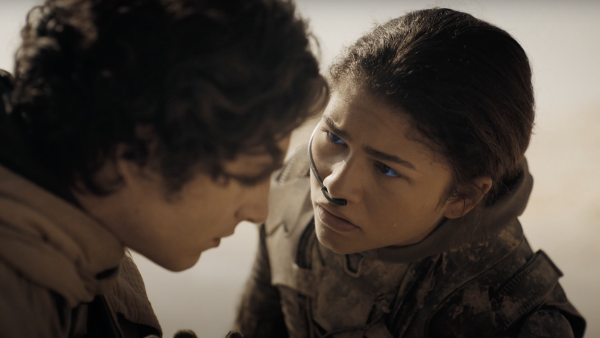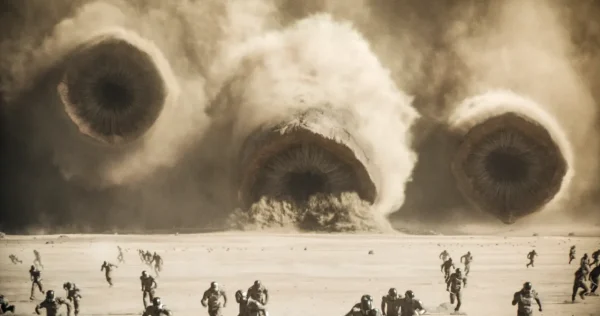There is not a single word in the English dictionary to describe how I felt watching this movie. No expression could surmount the beauty, terror, and magnificence of “Dune Part 2”, which was released on March 1st in theaters. It sent sensations through my bones, quite literally; the immersive Dolby Max experience shook the theater. If you cannot already tell, I am a bit of a “Dune” fanatic, having read the first 3 books, and can confidently say the world in which Frank Herbert crafted is something of a masterpiece, and was beautifully translated into the film.
Directed by Denis Villeneuve, “Dune Part Two” follows its 2021 predecessor, and covers the end of the first book, which is just one in a series of six. Part One begins with the story of Paul Atreides (Timothee Chalamet), son of Duke Leto Atreides (Oscar Isaac). The House Atreides is one of many different familial houses under the Imperial lead of Emperor Shaddam Corrino IV (Christopher Walken). House Atreides falls at the mercy of the brutal House Harkonen and Imperial forces after the Atreides were set up to fail by taking control of a desert planet called Arrakis, which is the sole producer of spice. Spice anchors the universe of Dune, as it is an addictive drug that is used by the Guild (space transporters) who use the spice to travel. Freemen, however, are one of the most important members of Dune Part Two. Freemen are natives of Arrakis, and after surviving the sabotage of Atreides, Paul, and his mother flee to the desert and join a Freemen Siege. Bene Gesserit are also especially important to the plot, as they are a cunning cult-like group of religious witches with genetic agendas on the line.
In Part 2, Paul tries to gain the respect of the Freemen tribe he has joined, all whilst falling in love with Chani (Zendaya), a young Freemen girl, and simultaneously attempting to gain revenge on the Houses and Emperor for the death of his family by gaining control of the universe and taking the throne. He does this with the help of his mother Jessica, a powerful and highly intelligent Bene Gesserit, who has taken on the powerful role of a Reverend mother in the siege. Jessica’s main route of control is spreading religious propaganda and legends around the desert people, attempting to rally them and promote her son as the Muad’dib (a religious name given to Paul by the Freemen).
To explain the extensive lore that encapsulates this universe the viewer embarks on is a tumultuous task, so to put it simply, this movie had the perfect balance of action, plots within plots, dialogue, beautiful set design, and music. Oh, the music. Hans Zimmer, the composer of Dune, was my top Spotify artist of 2023 for a reason. Zimmer forged new instruments for this movie to capture the otherworldly feel of the ginormous sets and rich orange color palette. Zimmer’s tracks are accompanied by unique rattling sand effects, raspy and booming female vocals, as well as heavy electric guitar, bass and electronic sounds. A perfect example of the impact that the music had on this movie would be the moment when Paul mounts a sandworm, a crucial moment, between Paul and Freeman where Paul gains their acceptance and approval. Villeneuve chose to use a powerful score in this moment, the track titled “Worm Ride” by Hans Zimmer, and the main “Dune” riff blasts the moment he sails through waves of dunes on the back of a ginormous beast, creating a monumental moment.
Another great factor in this movie was the color saturation throughout the storyline. Specifically, in the symbolism of the Harkonen house. I found it fascinating how they painted every audience member and Feyd Rautha [descendant to Baron Harkonen] of the Arena scene a pale white, making sure the set itself was all black. The dullness truly represents how heartless the Harkonens are in their devilish sport of drugging their opponents and feasting on the weak. Feyd Rautha, played by Austin Butler, interprets this heartlessness especially well. His performance is creepy and uncomfortable, it made me shiver. Villeneuve also does an excellent job of representing how the Harkonens act on predatory instincts, shown in a scene where Baron Harkonen is left in the desert to die, and ants crawl through his ear and feast on his remains, homage to the circle of life in the wild. The Baron, a massively obese body of fat, cannot hold his body weight and is carried by suspenders throughout the movie. He eats without thinking and does not act on reason. This weakness juxtaposes the Atreides, who are intelligent and have immense amounts of self-control. The color was the complete opposite when it came to the desert. The rich, deep, burning orange hues set the scene for passion and intensity throughout for religion and the creation of a messiah.
Though I didn’t agree with some of the casting, Villeneuve improves on the source material in some aspects, with his attention to minute detail and execution of action scenes. Herbert, though accomplished, falls short in his writing of battles and most importantly, the Jihad [the great war “Dune” is centered upon]. Luckily, the medium of film allows the battles to be performed with intensity and grand music roaring in the background.
But what would “Dune” be without an army of sandworms?  The ability to portray such massive creatures on screen, making them look so realistic and enormous is something I am still shocked by. With the budget “Dune” had, about $190 million, there was room for incredible CGI, spacious sets, and remote filming locations. Not to leave out the grand and impressive costume design for characters such as Princess Irulan [Florence Pugh], who is the daughter of the Emperor. I loved Pugh’s interpretation of Irulan, and I especially appreciate the armor-like head cover she wore towards an important battle scene. But aside from costume design, Irulan signified importance from just the first 10 minutes of the film. She opens with an excerpt from the book, catching the viewers up on the plot of Part One, while also introducing herself and her father as principal plot points.
The ability to portray such massive creatures on screen, making them look so realistic and enormous is something I am still shocked by. With the budget “Dune” had, about $190 million, there was room for incredible CGI, spacious sets, and remote filming locations. Not to leave out the grand and impressive costume design for characters such as Princess Irulan [Florence Pugh], who is the daughter of the Emperor. I loved Pugh’s interpretation of Irulan, and I especially appreciate the armor-like head cover she wore towards an important battle scene. But aside from costume design, Irulan signified importance from just the first 10 minutes of the film. She opens with an excerpt from the book, catching the viewers up on the plot of Part One, while also introducing herself and her father as principal plot points.
Though the movie is action-heavy, there is a special balance of quiet in between the storms. This is harbored by Chani and Paul’s budding relationship. Their chemistry on screen in a hazy desert was powerful to me as a viewer, and Zimmer uses a soft duduk [double reed wood instrument originating in Armenia] whenever the two are together. I think this shows the vulnerability of their relationship, as we see Paul move towards aristocratic leadership, and Chani begins to feel betrayed and hurt.
Overall, Dune is such a complex story of politics, religion, lust, power, mind, and control- so much more than spice and worms, (however, every time a worm came on screen, I did lose my mind.) Villeneuve interpreted the books beautifully and truly put the questionable and cheap 80s movie adaptations to shame, an opinion I will fiercely stand by.




